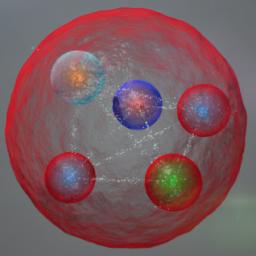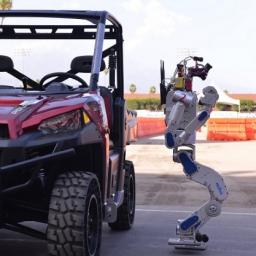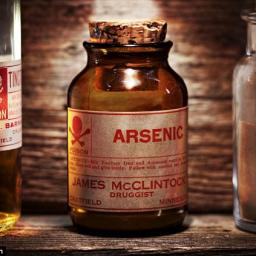
After restarting to run at higher power than ever, the Large Hadron Collider
has made its first proper discovery. Today, a team of scientists
announced that they've found a new class of sub-atomic particles known as
pentaquarks, a particle composed of four quarks and an antiquark.
From
BBC:
It was first predicted to exist in the 1960s but, much like the Higgs boson particle before it, the pentaquark eluded science for decades until its detection at the LHCb experiment. The findings have been submitted to the journal Physical Review Letters.
The
LHCb experiment is an experiment set up to understand what allowed matter to survive (as opposed to antimatter) by studying the properties of quarks.

Last weekend, 24 teams from around the world converged in Pomona, California to compete for the DARPA Robotics Challenge. DARPA launched the competition in response to the 2011 Fukushima earthquake and tsunami when, if robots been among the first responder teams, human lives could have been saved. Up in the grandstand, hundreds of excited children and parents were ready for a modern-day gladiator spectacle. "Will there be killer robots?" asked one boy, who was very disappointed to find out the steel humanoids were there to help, not destroy.
After a difficult assault course, designed around a hazardous environment, which required robots to drill through a wall, release a mounted valve, climb stairs and drive an off-road utility vehicle, Team KAIST from Korea
walked away with the $2 million first prize. In the end, the modification that set their DRC-Hubo apart was something that the other robots found difficult-the egress test-or getting out of the vehicle. Many of the other robots in the competition failed to dismount and had the indignity of their teams wheeling over the safety harness to tether and lift them out, losing points and time, before continuing other tasks. Team IHMC Robotics from the Florida Institute for Human & Machine Cognition came in second.
A theme emerged: robot competitions are here to stay. "We aren't in competition with each other," said Dr. Arati Prabhakar, DARPA Director. "Really we are in competition against the problems of the world." Aging populations, environmental disasters, and dwindling natural resources are serious issues. But the glory, prize money and the global glow of publicity are nice, too
When a group of modern humans began their exodus out of Africa,
Egypt may have been the last stop. Genetic similarities between Egyptians and Eurasians suggests that Pleistocene emigrants traveled through Egypt. If the route to Eurasia passed through East Africa, Ethiopians should be more genetically similar to Eurasians than Egyptians are. But according to Pagani, the opposite is true.
The "out-of-Africa" theory is the most widely recognized model for the movement of modern humans into Eurasia. It postulates that, at some point after the evolution of the first anatomically modern humans in Africa, there was a large migration out of the continent. Paleoanthropologists estimate that the move occurred between 125,000 and 60,000 years ago, but disagree on whether there was a single exodus or many. The prehistoric travelers, who may have used land bridges and simple rafts to cross, became the first modern human populations in Europe and Asia. (Fossil evidence suggests that
Neanderthals already occupied the continent).
Popular Science recently
reported on a wearable air quality monitor designed and prototyped by electrician, Kevin Hart, and nurse, Laura Moe. They are targeting a late fall 2015 release at a price point of $100 (US).
From the article, "A fan directly beneath TZOA's triangular cover sucks in air. As pollutants cross a laser, they scatter light onto a sensor that counts them. TZOA then glows a color corresponding to the air safety level. A smartphone app also displays that data, along with daily UV light exposure and crowdsourced pollution maps."
The
Canadian Broadcasting Corporation reports that two researchers have stepped down from the Science Hall of Fame selection panel over claims that cultural bias is limiting the number of female researchers nominated for the honour. No female researchers have been nominated for two years running and former panelists Judy Illes and Catherine Anderson argue in their resignation statements that the lack of nominations reflects a cultural bias that fails to reflect the contributions women make to science nationally and globally.
Anecdotally, the gender bias claims echo how the work of Rosalind Franklin was rewarded in her lifetime following the discovery of the structure of DNA. As
a Wikipedia summary notes: "Franklin is best known for her work on the X-ray diffraction images of DNA while at King's College, London, which led to the discovery of the DNA double helix. According to Francis Crick, her data and research were key in determining the structure. Watson confirmed this opinion in his own statement at the opening of the King's College London Franklin-Wilkins building in 2000 and formulating Crick and James Watson's 1953 model regarding the structure of DNA. Franklin's images of X-ray diffraction, confirming the helical structure of DNA, were imprudently shown to Watson by Wilkins without her permission. Her work was published third, in the series of three DNA Nature articles, led by the paper of Watson and Crick. Watson, Crick and Wilkins shared the Nobel Prize in Physiology or Medicine in 1962. Watson suggested that Franklin would have ideally been awarded a Nobel Prize in Chemistry, along with Wilkins."
A
new report out of Canada suggests that high numbers of students at Canadian universities involves the acceptance of too many "marginally talented" students. University of Saskatchewan researcher, Ken Coates,
has proposed reducing Canadian university student populations by 30% -- to be complemented by an increased emphasis on job training programs at technical colleges -- to improve the education and employment outcomes of all student cohorts.
A
Council of Ontario Universities report from 2014, entitled University Works, provides a counter-argument to this narrative, however. According to
a summary article, the earlier report claims that "over 40 years, a university graduate earns an average $915,840 more than a college graduate and $1.4 million more than a high school graduate" reinforcing the long-standing idea of the greater return on investment supplied by a general university degree.
An easier to squeeze mayonnaise bottle might be
coming out this year, and easier to squeeze toothpaste could be here in 2017. This is thanks to a liquid-impregnated coating called LiquiGlide that can keep the inside of a container permanently wet and allow its contents to easily slide out. Elmers Products, Inc. is on board, too, and has already signed a contract with LiquiGlide to let you get every drop of glue out of the bottle. Follow the link for videos of the coating in action.
LiquiGlide is a liquid coating that binds much more strongly to textured surfaces than to liquids, so when it's painted onto the inside of a container, the liquid can flow freely over it without creating friction and viscosity. It was originally created in 2012 by a professor, Kripa Varanasi and his grad students at MIT. They've formed their own LiquiGlide company, and it's now getting some traction among consumer products. However, the original intent behind LiquiGlide was not to make it easier to have ketchup with your fries. Varanasi was thinking about industry applications like more efficient oil pumping. For now, the company has found success in consumer products, but it will continue pursuing industry application ideas too.

It is one of the most toxic substances known to man and has been used to poison kings, emperors and even prize winning racehorses. Worldwide arsenic poisoning caused by contaminated water and food is thought to harm more than 137 million people. Even low levels of arsenic poisoning can cause damage to the lungs, heart, kidneys and liver, leading to cancer, heart disease and diabetes. But scientists have discovered one small population of people living in a remote part of the Andes in north west Argentina who
have developed some resistance to arsenic. They have found that over thousands of years the local inhabitants there have developed a genetic ability to metabolise the arsenic to reduce the impact it has on their bodies. They found one gene in particular - AS3MT, which is thought to play a role in arsenic metabolism - occurred in far higher frequencies compared to populations living in Columbia and Peru.
Researchers from the Swiss Federal Institute of Technology have developed a pair of
telescopic contact lenses with 2.8x magnification. Really just a pair of super-tiny aluminum telescopes, the contacts are still only about 1.5 millimeters thick, and feature 1 mm-wide channels or pores that allow the required breathability - maintaining airflow. This last part proved to be one of the biggest challenges, requiring years of experimentation.
While the contacts do all the work, they currently require polarized glasses to turn the magnification on or off. That said, the researchers are working towards an on/off capability - activated by winking. "We think these lenses hold a lot of promise for low vision and age-related macular degeneration (AMD)." But will a wider and more general user-base be interested in contact lenses that covertly give them super-human telescopic vision?
Scientists have created
a new water-hating material by laser-etching a microscopic pattern on a metal surface. The surface could be used for everything from preventing ice from developing on airplane wings to creating self-cleaning toilets. And unlike traditional chemical coatings, the new material will not wear off, the researchers say.
It's much more repellent than typical chemical coatings, like the Teflon in nonstick frying pans. Teflon-coated surfaces need to be tilted at nearly a 70-degree angle before a water droplet will slide off, whereas the new material only needs to be tilted at less than 5 degrees, the researchers reported in the Journal of Applied Physics. To create the new material, Guo and his colleagues used powerful, but very short, laser pulses to etch a platinum, titanium or brass surface. Currently, it takes an hour to etch a 1 inch by 1 inch (2.5 by 2.5 centimeters) piece of metal, so this process needs to be sped up.
 After restarting to run at higher power than ever, the Large Hadron Collider has made its first proper discovery. Today, a team of scientists announced that they've found a new class of sub-atomic particles known as pentaquarks, a particle composed of four quarks and an antiquark.
After restarting to run at higher power than ever, the Large Hadron Collider has made its first proper discovery. Today, a team of scientists announced that they've found a new class of sub-atomic particles known as pentaquarks, a particle composed of four quarks and an antiquark.
